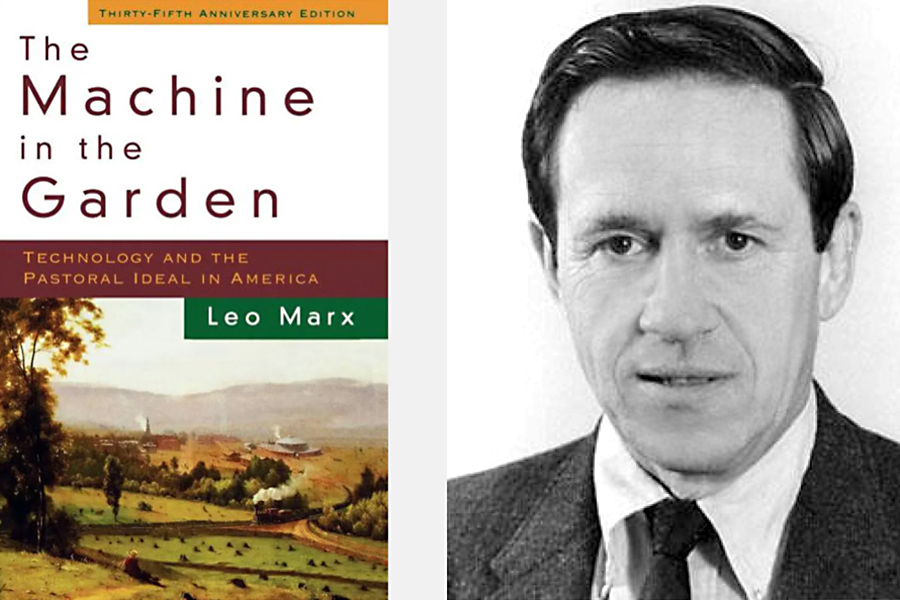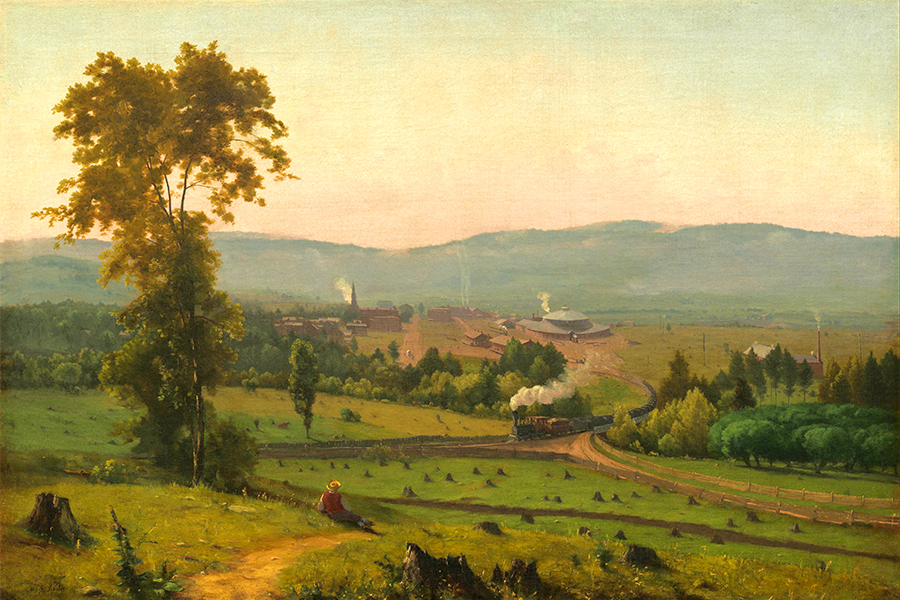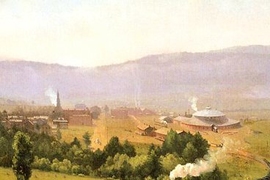Leo Marx, internationally famed scholar of American history and founding member of MIT’s Program in Science, Technology, and Society (STS), died on March 8 at his home in the Jamaica Plain neighborhood of Boston. He was 102.
Respected and beloved as a scholar, teacher, colleague, and friend, Marx provided decisive leadership in giving the humanities a central academic role at MIT.
Marx, the William R. Kenan Jr. Professor of American Cultural History, emeritus, is best known as the author of “The Machine in the Garden: Technology and the Pastoral Ideal in America” (Oxford University Press, 1964). Based on his Harvard University doctoral dissertation, the book identifies a fundamental contradiction in American literature and life. The wide-open American landscape seems to incarnate the imagined “middle landscape” of the ancient Greek and Roman pastoral poets, where human beings live in harmony with the rest of nature. At the same time, the rich and expansive New World encourages ambitions for the mastery of nature. In America, pastoral dreams of harmony coexist with machine dreams of control.
A new lens for American history
The book title has become a familiar phrase, but it is the subtitle that best reflects the book’s complex theme. The “pastoral ideal,” which dates to antiquity, refers to a mode of literature that idealizes country life. The idea of “technology” dates back at most a couple centuries and has become identified with practical, money- and power-making enterprises such as employment, engineering, management, warfare, and production. How could these two words and ideas belong in the same title? What do they have to do with each other and with American history?
Marx was among the first in the U.S. academic world to practice deeply interdisciplinary scholarship. He highlighted the role of literary analysis in understanding technological history because, as he wrote in a syllabus for one of his graduate classes, imaginative writers “rarely take technology and its relations with the rest of society and culture as their primary or explicit subject. Indeed, it is precisely the kind of indirect or tacit significance attributed to the role of technologies in literary works that makes studying them particularly valuable.”
This was a new approach in mid-20th century historical studies, and it provided a sharp new lens for viewing both American and industrial history. Marx used this lens to study images and episodes that are dramatic and revealing: the whistle of a steam train shattering the quiet woods of Thoreau’s “Walden,” or a steamboat crashing into a raft on which Jim and Huck float down the Mississippi in Twain’s “The Adventures of Huckleberry Finn.”
The making of a classic
Getting from basic insight — the power of imaginative literature in understanding technological change — to published book took Marx a long time. As an undergraduate at Harvard in the late 1930s, concentrating in history and literature, he was already intrigued by ways imaginative American writers engaged with the emerging power of industry. When he graduated in 1941, however, the world was at war. He joined the U.S. Navy and spent most of the next four years serving on, and eventually becoming captain of, a sub-chaser.
After the war’s end in 1945, Marx returned to Harvard as a doctoral candidate in a program titled History of American Civilization. While researching dissertation ideas, he read a book review claiming that an American writer of the 1890s was among the first to respond to industrialization. This assertion struck him as obviously wrong because he could immediately think of writers (including Herman Melville, Nathaniel Hawthorne, Ralph Waldo Emerson, and even Thomas Jefferson) who had responded to industrialization much earlier. So in his doctoral dissertation Marx provided a more accurate account of early responses to industrialization in America.
He received his PhD in 1950 and went to work in the English Department at the University of Minnesota. With his wife, Jane Pike Marx, whom he married during the war, Marx moved to Saint Paul. He began to hone his teaching skills at Minnesota’s well-regarded public university, while also serving as a visiting professor at other institutions, including the University of Nottingham in England and Amherst College in Massachusetts.
In 1958, Marx accepted an offer to join the Amherst College faculty as professor of English and American studies. Then almost 40 years old and still revising his dissertation, Marx asked one new colleague for what he hoped would be a final review. Benjamin DeMott’s feedback was: “This is a good book about other books. If you make it into a book about America, you will have a great book.”
Marx responded with a thorough revision, and “The Machine in the Garden” was finally published six years later. “From Day One, 'The Machine in the Garden' was considered a history of technology classic,” says MIT’s Merritt Roe Smith, the Leverett and William Cutten Professor of the History of Technology. “It was also,” he adds, a “pioneering work that helped, more than any other book, to define the field of American studies during the 1960s.” While almost 60 years have passed since the book’s appearance, its scholarly quality, originality, and significance continue to stand the test of time.
Origin story
Marx stayed at Amherst for 18 years, earning a reputation as a legendary teacher. In 1975, he accepted an invitation from MIT President Jerome Wiesner, Provost Walter Rosenblith, and historian of technology Elting Morison to come to MIT to help create a College of Science, Technology, and Society, intended to connect all of MIT’s existing schools in a mission that would include an undergraduate program, a research center, and fellowships. Marx joined the MIT faculty in 1976 as the William R. Kenan Jr. Professor of American Cultural History and helped developed innovative courses, but the ambitious plans for a new college ran into fiscal limitations. The experiment, which lasted five years, until 1982, had planted many seeds for the future.
And what remained was a very fine Program in Science, Technology, and Society (STS) within the School of Humanities and Social Science (forerunner of today’s School of Humanities, Arts, and Social Sciences.) To attain more stability, STS faculty then worked to start a graduate program, and in 1987 received provisional approval for what is now MIT's Doctoral Program in History, Anthropology, and Science, Technology, and Society (HASTS). The extraordinary success of the HASTS program proved pivotal in launching STS into its current status as a leader in the field, renowned within and beyond MIT.
Throughout this period, Marx was “the intellectual heart and soul of the STS program — in large part because he believed in it so much,” says Sherry Turkle, the Abby Rockefeller Mauze Professor of the Social Studies of Science and Technology. By the time STS had stabilized in 1990, Marx had been at MIT for 14 years and was one of the last MIT faculty subject to mandatory retirement. However, retirement seemed only to reinvigorate him; as Kenan Professor Emeritus and senior lecturer, Marx continued to publish and to teach at MIT almost every semester through 2010.
The meanings of nature, environment, technology, progress
By the 1990s, Marx’s scholarship had been moving toward interdisciplinary environmental studies, where nature and technology converge. Along with Jill Ker Conway and Kenneth Keniston, he organized a multi-year lecture and discussion series that led to a book intended for a general audience: “Earth, Air, Fire, Water: Humanistic Studies of the Environment” (University of Massachusetts Press, 2000).
At the same time, technology was increasingly being identified with digital devices and systems. For many decades Marx had been exploring the meaning and evolution of technology in a string of articles on topics such as Heidegger’s concept of technology, technological pessimism, and the concept of progress. All these studies converged in an article titled “Technology: The Emergence of a Hazardous Concept,” first published in 1997, and then again in 2010 in the journal Technology and Culture.
To challenge the key concept in the history of technology as hazardous is both provocative and persuasive: Marx’s article has become among the most cited in the long history of Technology and Culture. Through additional essays and articles, Marx ultimately built up an intellectual history of the concepts of nature, environment, technology, and progress, as these terms continue to co-evolve. Even today, the seeds of his ideas sprout up in countless reviews, conversations, and classroom discussions.
Humming classrooms
Marx also leaves a rich legacy as a teacher — influencing not only students but colleagues. “Everyone in the program wanted to teach with Leo, and in turn, every one of us, I think, did because it was a profound mentorship in how to make a classroom work,” Turkle says, adding how impressed she was by “Leo’s ability to turn a seminar into a humming collaborative experience.”
David Mindell, a professor of aeronautics and astronautics, and the Dibner Professor of the History of Engineering and Manufacturing in STS, is also one of Marx’s STS graduate students. He says Marx’s standards for good writing were clear and high. “One could not ask for a kinder, gentler person to slice a young scholar’s early writings to the bone,” he says, noting that Marx once gave him 11 pages of handwritten comments on a draft. “He made me a better writer, a better thinker, and a better historian, and left similar marks on many others.”
Beyond MIT, Marx turned the world into his classroom. He did an enormous amount of public speaking, mentoring, editing, advising, and debating in all sorts of settings, all around the globe. David Nye, an American historian who spent most of his academic career in Denmark, says “I doubt there is a single nation in Europe that he did not visit to attend a conference or give a lecture.”
Wherever he went, Marx was treasured for his ability to listen. “Leo’s quality of mind was exhibited time and again in public settings,” Smith recalls. “He had the extraordinary ability to ask very perceptive, penetrating questions.” Nye adds, “Leo was a fantastic listener and gave incisive advice.”
An ongoing legacy
Today, Marx’s insights live on. A few weeks before his death, Marx’s daughter was contacted by Klaudio Štefančić, curator of the National Museum of Modern Art in Zagreb, Croatia, who was seeking permission to use the title “The Machine in the Garden” for a forthcoming art exhibition. Marx admired the exhibition catalog and was pleased to see his inspiration at work in an unexpected quarter.
For his part, Štefančić says Marx's book inspired him “to search for broad meaning in art and to work in an interdisciplinary way.“ In his catalog essay, he extends Marx's insights to another time, place, and art form, showing how Marx’s ideas continue to provide a reliable framework for understanding the modern world. The essay concludes: “We will not be able to imagine future society without the symbols of the garden and the machine.“
MIT professors Rosalind Williams (emerita), David Mindell, Merritt Roe Smith, and Sherry Turkle; professor emeritus David Nye of the University of Southern Denmark, and family member Lucy Todd Marx, contributed to this remembrance.








